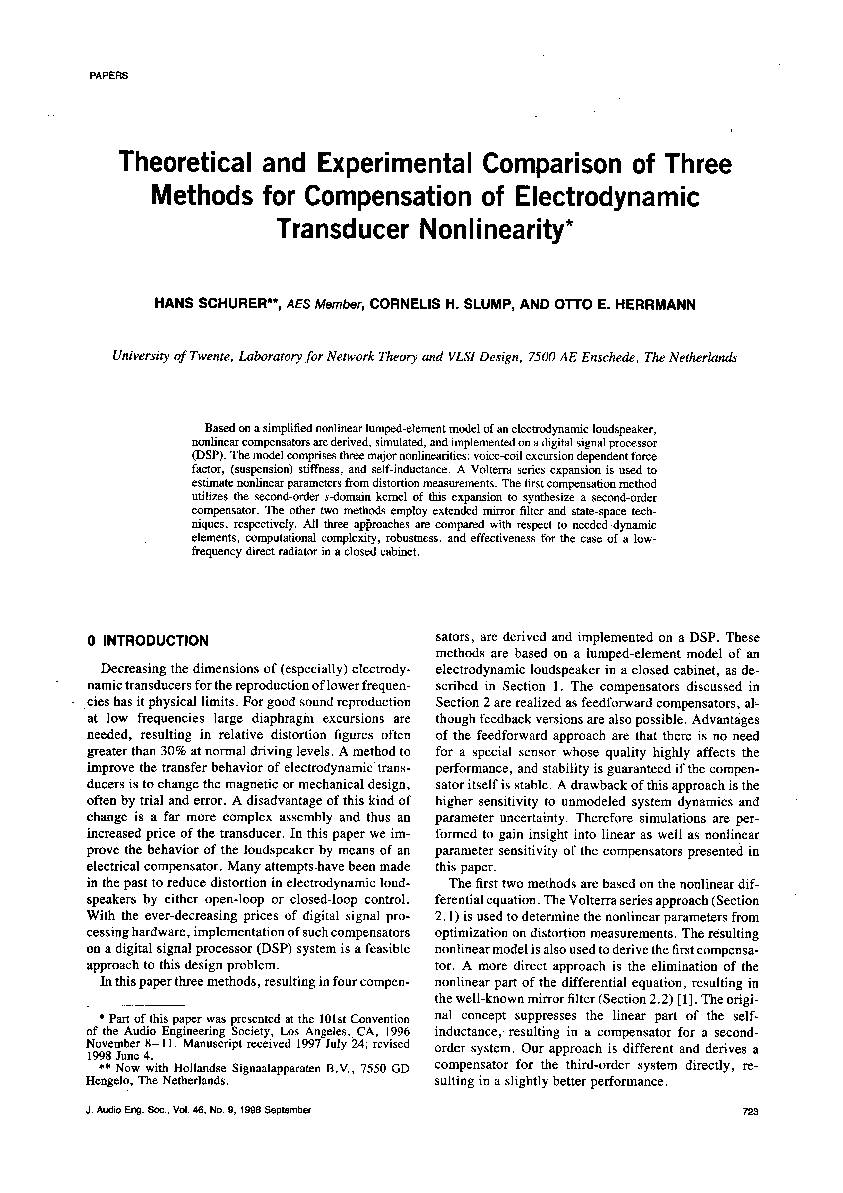Home / Publications / E-library page
You are currently logged in as an
Institutional Subscriber.
If you would like to logout,
please click on the button below.
Home / Publications / E-library page
Only AES members and Institutional Journal Subscribers can download
Based on a simplified nonlinear lumped-element model of an electrodynamic loudspeaker, nonlinear compensators are derived, simulated, and implemented on a digital signal processor (DSP). The model comprises three major nonlinearities: voice-coil excursion dependent force factor, (suspension) stiffness, and self-inductance. A Volterra series expansion is used to estimate nonlinear parameters from distortion measurements. The first compensation method utilizes the second-order s-domain kernel of this expansion to synthesize a second-order compensator. The other two methods employ extended mirror filter and state-space techniques, respectively. All three approaches are compared with respect to needed dynamic elements, computational complexity, robustness, and effectiveness for the case of a low-frequency direct radiator in a closed cabinet.
Author (s): Schurer, Hans; Slump, Cornelis H.; Herrmann, Otto E.
Affiliation:
University of Twente, Laboratory for Network Theory and VLSIDesign, Enschede, The Netherlands
(See document for exact affiliation information.)
Publication Date:
1998-09-06
Import into BibTeX
Permalink: https://aes2.org/publications/elibrary-page/?id=12134
(1767KB)
Click to purchase paper as a non-member or login as an AES member. If your company or school subscribes to the E-Library then switch to the institutional version. If you are not an AES member Join the AES. If you need to check your member status, login to the Member Portal.

Schurer, Hans; Slump, Cornelis H.; Herrmann, Otto E.; 1998; Theoretical and Experimental Comparison of Three Methods for Compensation of Electrodynamic Transducer Nonlinearity [PDF]; University of Twente, Laboratory for Network Theory and VLSIDesign, Enschede, The Netherlands; Paper ; Available from: https://aes2.org/publications/elibrary-page/?id=12134
Schurer, Hans; Slump, Cornelis H.; Herrmann, Otto E.; Theoretical and Experimental Comparison of Three Methods for Compensation of Electrodynamic Transducer Nonlinearity [PDF]; University of Twente, Laboratory for Network Theory and VLSIDesign, Enschede, The Netherlands; Paper ; 1998 Available: https://aes2.org/publications/elibrary-page/?id=12134
@article{schurer1998theoretical,
author={schurer hans and slump cornelis h. and herrmann otto e.},
journal={journal of the audio engineering society},
title={theoretical and experimental comparison of three methods for compensation of electrodynamic transducer nonlinearity},
year={1998},
volume={46},
issue={9},
pages={723-740},
month={september},}
TY – paper
TI – Theoretical and Experimental Comparison of Three Methods for Compensation of Electrodynamic Transducer Nonlinearity
SP – 723 EP – 740
AU – Schurer, Hans
AU – Slump, Cornelis H.
AU – Herrmann, Otto E.
PY – 1998
JO – Journal of the Audio Engineering Society
VO – 46
IS – 9
Y1 – September 1998